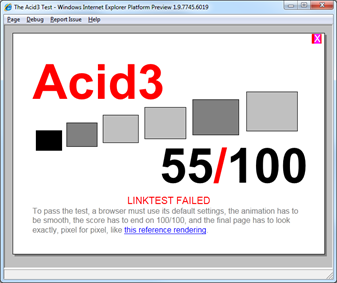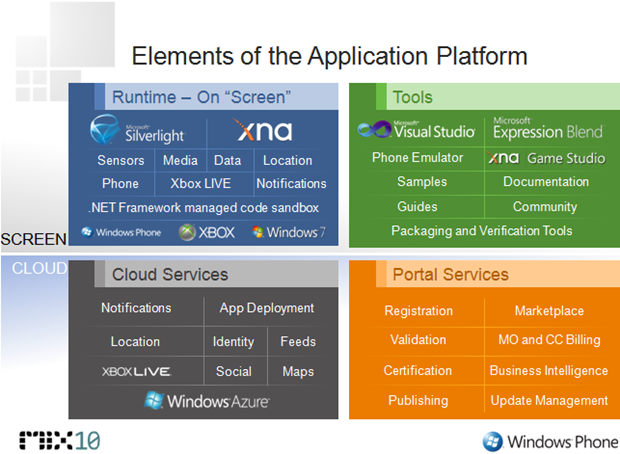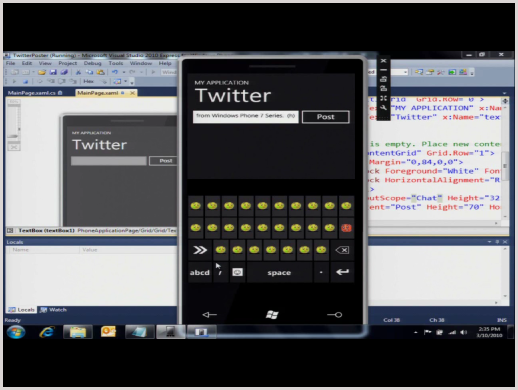 Another year, another MIX conference in Vegas and another three days of reading all the news from afar. Fortunately the Twitter age doesn’t leave those of us on the other side of the world completely isolated and there has been some really interesting news shared by those on the ground in the US.
Another year, another MIX conference in Vegas and another three days of reading all the news from afar. Fortunately the Twitter age doesn’t leave those of us on the other side of the world completely isolated and there has been some really interesting news shared by those on the ground in the US.
Here’s a summary of what I found interesting and what I see is significant for the technologies involved. It’s by no means a comprehensive review – one look at the sessions list will confirm that – but it’s what jumped out and got me excited.
Internet Explorer 9
Back at PDC in November we were seeing early looks for developers but now there’s actually a test-drivable version available in the form of a Platform Preview. Of course there are some gaps between the preview and the intended functionality of the full release edition but it’s a good first look at a functional version.
HTML5 was always going to feature heavily in IE9 but what’s really interesting is support for H.264 MPEG-4 video. This is important stuff as the same high definition encoding is being used for formats such as Apple QuickTime and DivX as well as having been introduced in Silverlight 3 so it’s starting to bring unprecedented video format consistency to the digital age. YouTube is using it in their HTML5 test site and even Camtasia now sets it as the default output format so the writing is well and truly on the wall.
IE9 is also bringing us some serious inroads into CSS3 compatibility. Microsoft is reporting a 55/100 score in the Acid3 test which although an improvement on the 20/100 I just got on IE8, is still a long way short of the 94/100 on Firefox 3.6 and 100/100 on Chrome 4.0. Quite frankly, I’m not quite sure that Microsoft crowing about this result is a wise move. Sure it’s a great improvement on IE8 but seriously, this browser is still quite a while off and is only passing half the tests that Chrome does today.

Just how bad is IE8 when it comes to CSS3 (and consequently, how far does IE9 need to improve)? Check out the Opera logo rendering compared to the other major players:

IE9 also brings SVG (Scalable Vector Graphic) support which means a real viable alternative to the bad old raster days. Of course SVG is already supported to some extent in all other major browsers so it’s another case of playing catch-up rather than driving innovation.
It also looks like IE9 will be the first Microsoft browser in a long, long time that won’t run on Windows XP. It will be interesting to see how this decision affects uptake given Wikipedia’s usage share stats say XP still accounts for more than half of all OS installs. Worse still, IE6 is still out there as the browser of choice for over 20% of users so the chances of us seeing much use of HTML5, CSS3 and SVG in the next few years without serious work going into down-rendering for other browsers is slim.
Windows Mobile 7
We all know Microsoft is now well and truly behind the eight ball in terms of the mobile platform and that they also tend to, how can I put this - “leverage” – the work done by other organisations but I was a bit surprised at the extent of the similarities to the Apple strategy based largely on Mary-Jo Foley’s post. Consider the following similarities:
- No multitasking by third part apps.
- Apps can only be purchased (and installed) through the official manufacturer channel.
- No copy and paste.
- More consumer oriented than business focussed.
The lack of copy and paste really blew me away. I find it stunning that after the trials Apple had to go through before realising the error of their ways and bringing it into OS3 Microsoft would actually drop it from their mobile platform! The negativity surrounding this decision is deafening and despite what Microsoft says about “smart linking” negating the need for this feature, I’m predicting we’ll see them buckle under public pressure (particularly from business) and bring it back again. In fact as the news broke and public dissatisfaction roared in, a far more metered response was heard from Microsoft:
We’re always listening to feedback and will continue to improve our feature set over time based on what we hear.
The move to a more consumer based model to the detriment of the enterprise is going to cause some serious ripples across the business application development space. Decisions such as only delivering applications through the Windows Phone Marketplace could quite likely close the door on organisations who simply aren’t prepared to put their business applications out into the public marketplace. Having said that, it’s still early days and Microsoft don’t appear to be completely cemented on this path. Then again, now that Silverlight is slated to run on WM7 there’s always the option to build rich apps in XAML and load them on demand over HTTP (assuming readily accessible connectivity is available).
Of course the other alternative for business is to focus on building HTML based apps assuming the solution doesn’t have dependencies requiring it to execute on the device. With WM7 supporting HTML5 (also already supported by the iPhone!), the potential to deliver richer applications is there, particularly when it comes to leveraging device features such as GPS geolocation services. The other advantage of this approach is that apps become more generically mobile friendly and play nice across a much broader range of devices.
Fortunately it’s not all bad news and Microsoft appears to have learnt something from Apple, namely that consumers want Flash to run on the device and are reportedly in talks with Adobe to make it happen. Unsurprisingly it will also feature Silverlight compatibility so there is serious potential for developers to leverage the rich media functionality WM7 devices will support.
In terms of other positive news, it looks like WM7 gets DivX support (albeit not the latest DivX7) so that should open doors to a lot of the media currently being produced in this format. Also on the video front is NetFlix movies on demand which has some serious “wow” factor assuming you’re located in the US and can actually get an account!
Lastly, the ubiquitous Microsoft architecture diagram which explains everything about WM7 is somehow related to everything else they do (yes, even to the XBOX!):

Silverlight 4
 Another year, another Silverlight version. The velocity continues to be astounding; there was only just over 8 months between Silverlight 3 RTW and version 4 RC which has just been made available so Microsoft is turning over entirely new versions in well under a year. We should be seeing the final release next month in April. Of course along with the new version comes new tooling so there’s a whole new Expression Blend 4 now available (in beta) and I assume the rest of the Expression Suite will follow shortly.
Another year, another Silverlight version. The velocity continues to be astounding; there was only just over 8 months between Silverlight 3 RTW and version 4 RC which has just been made available so Microsoft is turning over entirely new versions in well under a year. We should be seeing the final release next month in April. Of course along with the new version comes new tooling so there’s a whole new Expression Blend 4 now available (in beta) and I assume the rest of the Expression Suite will follow shortly.
Feature wise, I’ve pretty much covered it all in my PDC09 Roundup post last year. Printing, new controls (including rich text), elevated out of browser privileges, device access, implicit styling and cross domain service access are some of the things we can look forward to in the very near future.
Uptake wise, last year’s PDC announced 45% of all internet connected devices were running Silverlight and in the MIX10 keynote Scott Guthrie reported this figure as now being 60% and “accelerating rapidly”. Of course Silverlight powered the Vancouver Winter Olympics (as it did the 2008 Beijing Olympics) so there’s plenty of compelling content driving the uptake. Embedding it in WM7 will seriously drive the “connected devices” numbers once new phones start to roll out.
I wasn’t sure whether to put this next piece of info in the WM7 section or the Silverlight section which is a great dilemma to have because it means Silverlight is well and truly going mobile (it’s here because I have less Silverlight content)! There’s a great little video over on Channel 9 about creating a Twitter client in Silverlight for WM7. These days Twitter clients are the Hello World of rich app demos so it’s not surprising to see this video appear. Besides, it’s a really neat overview which shows how easy it is to take existing Silverlight knowledge and start building rich mobile apps without needing to know much about device specific coding.

Bing
The Bing banner is now being applied to a range of services but let’s start with the really important news; the blue colour #0044CC is going to generate Microsoft $80M by making it the colour of choice for Bing search links. Obviously the current #0033CC just isn’t cutting it!
Moving on to more interesting news, Bing has released its WorldWide Telescope Application which brings star gazing into Bing Maps. Celestial browsing is no longer cutting edge – there’s always Google Moon and Google Mars – but the neat thing about the Bing app is that it’s real-time; what you see on the map is what you see when you go outside and look up at the stars right now.

As much as Bing is making some good steps forward in terms of funky features, I still believe there needs to be a bit more effort put into the basics. Mapping and particularly aerial imagery, for example, are still way behind Google. Take these two views of Versace on the Gold Coast:
The left image shows the Bing picture which zooms down to the point where this image source (click the picture to view it) can be scaled to 351x177 pixels at maximum zoom. The same scene on Google maps on the right (again, click to view source) scales all the way down to 2753x1389 pixels so there is a massive fidelity advantage to Google. I know this is Australia specific and I suspect the story is different in the US but I’ve noticed similar comparisons in parts of Asia so there certainly seems to be a bit of a trend here.
Summary
We’ve seen some excellent announcements come out of Microsoft this week and I’m certainly going to make use of many of these in my work over the coming years. However I do keep getting the recurring feeling that Microsoft is playing catch-up; HTML5, CSS3, SVG, WM7 strategy, mapping (celestial or otherwise), are all great but they’ve all been done before.
I’d love to think they could do it better than their predecessors and learn from the mistakes made by those before them but then you see decisions like no copy and paste on WM7 you have to wonder if Microsoft has just entirely lost the plot! Still, there is true innovation in amongst the hype and the fact they’re really pushing to get standard compliant with things like browser and video compatibility is a positive sign.
Lastly, Microsoft still has the advantage of having a huge audience of both consumers and developers and all the products listed above have the potential to appeal greatly to both these audiences. The new offerings might be a little behind the eight ball but it does bring more competition to the marketplace and in anyone’s book, that’s a very positive thing indeed.

